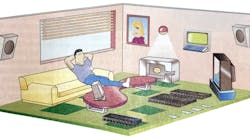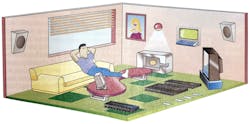Latest from Industry Perspectives
A New Chapter for Electrical Wholesaling
Sponsored
As part of our celebration of Electrical Wholesaling magazine’s upcoming 100th anniversary in April 2020, we will be reflecting on —and occasionally poking a little fun at — some of our feature articles that have been published over the years.
This time we’ll take a brief look back at one of the “trend” features foretelling a future that didn’t quite work out that way. A July 1992 article (of astonishing length) titled “Automated Homes” explored the promise of several systems that had been developed to popularize home automation. The thinking was that electrical distributors were in position to grab onto a huge surge in demand for in-home networking systems that would integrate power, audio, video and data services.
In those days, the vision of a responsive home that could tune its environment to the changing needs of the family going about its day was pretty new and shaped by science fiction television series such as Star Trek or the animated cartoon The Jetsons. You have to remember there was no such thing as WiFi then, the World Wide Web had just been invented but no one knew about it yet, even e-mail was still in its infancy.
The story told of an ambitious effort called Smart House, a consortium of manufacturers who envisioned creating a new home-wiring standard to replace all conventional electrical wiring. The system was based on a flat specialty wire that would combine power, audio, video and data cabling connected to a system controller.
The article described the capabilities envisioned for a home equipped with a Smart House system: “The breadth of Smart House’s control encompasses electricity, gas, security, heating, communications and entertainment. Once the system is fully operational, any switch in the home can be enabled to operate any Smart device or enact a programmed sequence of activities.
The press of a rocker switch in the master bath starts the whirlpool tub filling with water to a preset depth and temperature, dims selected lights to preset levels, closes the blinds, rotates a clothes carousel in the closet to put the bath robes to the front, activates the security system to notify the master bath if anyone approaches the perimeter of the house and puts on some polka music.”
From the outset Smart House was to be installed by electrical contractors and sold through the traditional electrical distribution channel.
“As a standard that replaces the electrical system in the house, it is expected to be installed by the electrical contractor, because he currently does it. (Otherwise) you’re trying to put everybody out of a job,” said Dennis Gates, who was the director of distribution for Smart House. “We expected he would want to buy the product at the same location he currently buys his conventional materials, which is the conventional electrical distributor. No magic to the thing, just common sense.”
Because the consortium included competing manufacturers in many product categories the products would be purchased directly from the manufacturers, not through Smart House, so would strengthen their existing supplier relationships while growting a new market.
The initial inventory requirements were modest and some electrical distributors invested substantially in promoting the Smart House dream, but the market never materialized. A quote in the story from home technology analyst Tricia Parks of Parks Associates hints at where the trouble lay.
“Smart House is not a real option for a standard,” she said, “Unless they come up with a good solid solution for the retrofit environment, and they don’t have that yet. They need to get a wireless media in there, like power-line carrier or RF (radio frequency).”
Today, of course, with the mainstream embrace of voice interfaces such as Amazon’s Alexa and the spread of intelligent HVAC systems and connected lighting platforms that integrate into the Internet of Things, the tide has turned again. With WiFi almost universal, the systems installed to automate a house aren’t dependent upon premium proprietary wiring systems, specialized load centers and system controllers sold through electrical distribution.
Alas, no distributors made their fortunes selling the future in the form of Smart House. But those who want a fully automated home have little trouble creating one, and in lighting especially the systems have more varied capabilities than anyone envisioned in 1992. Cue the polka music.



